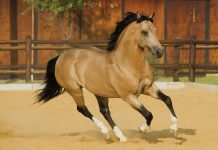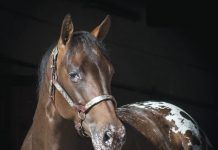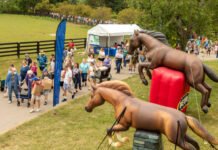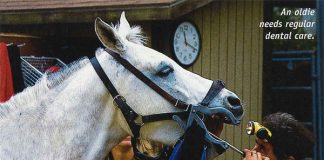If your horse or pony can walk, trot and canter calmly and he halts when you ask him to, you could try doing a dressage test at a show this year. Dressage is just a fancy French word for training, and when you ride your horse on the flat, you’re doing dressage.
So, what is a dressage test? It’s a series of movements, for example, circles and transitions that you do in an arena. The arena has letters around it which let you know where you’re supposed to do each movement. A judge watches your test and scores you on how well you and your horse complete each movement. If you do a lumpy, oval circle you’ll get a low score. If you do a perfectly round 20-meter circle, you’ll get a high score.
There are dressage tests for every level of rider and horse. If you or your horse is a “greenie,” you could do one an “Intro Level” test in which you only walk and trot. Easy! If you’re a little more advanced you could do a “Training Level” test in which you walk, trot and canter. If your horse can do movements like leg yields, you could try a “First Level” test.
Most kids start out by doing Intro or Training Level tests. To learn more about each test, check out the United States Dressage Federation’s website at www.usdf.org. You can also ask your trainer, or friends who do dressage, to share copies of their tests with you.
Once you find a show and decide which test you’re going to do with your horse, it’s time to practice!
Arena Letters
For lower level tests, a dressage arena has eight letters as shown: A, K, E, H, C, M, B, and F. It’s easy to remember them. Just say “All King Edward’s horses can make big fences.” You’ll be asked to do different movements at each letter. For example, “canter at K” or “turn right at C.” X is right in the middle of the arena, between E and B. X is where you normally begin and end a test.
Learn Your Test
Be professional and memorize your test. Draw an arena on a piece of paper and use a pencil to “ride” the test several times. You’re allowed to have someone stand by the arena and read the test to you while you compete in the lower level tests, but if you’re only doing one test, we think you can learn it by heart—it’s not that hard!
Set Up An Arena
Once you’ve memorized the test, it’s time to practice it on your horse. If you want to be successful at the show, it’s essential that you set up a dressage arena in your field or arena to practice your “geometry.” Put some jump poles on the ground and set up a ring that’s 20 meters by 40 meters (66 by 131 feet.) Buy some inexpensive plastic trash cans or rubber cones and paint the letters on them and then set them up around the arena.
All The Right Moves
Even though you’ve memorized the test, don’t do the test over and over on your horse. Why? It’s boring for him, and he’ll anticipate the movements. You want him to wait for your commands before he canters or trots, not jigging because he knows what’s coming up next. Practice the movements separately and then put them together for the test once at the end of each schooling session. Let’s take a look at some of the movements you should practice before your test.
Straight Lines
All tests ask you to enter at A and then head down the middle of the arena. Pure dressage tests ask you to halt at X, but some eventing dressage tests let you zip right by X without halting. Whether you halt or not, practice going straight down the middle of the arena. Many horses wiggle from side to side and don’t move forward on a straight line.
Keep your reins even and stay balanced in the middle of the saddle. Think “straight, straight, straight” as you head towards X or C. Try to keep your horse’s whole body straight, with his head directly in front of him, as you ride down the long sides of the arena as well.
Halt And Salute
Practice the halt at X—and in other places around the arena too. Most tests ask you to halt from the trot, so think about sitting deep in the saddle, squeezing on the reins and asking your horse to come to a complete stop. He should stand squarely—all four legs underneath him as shown—so he gets a good mark for the halt. If one leg is more forward than the other one, ask him to back up or move forward until he stands squarely.
You’ll lose marks if you don’t salute. Put both of your reins in your left hand and then drop your right hand down by your side as shown. Your horse should stand still while you salute. No fidgeting allowed!
Transitions
Your horse must do transitions the second you ask for them if you’re going to get high marks in dressage. When you ask for the canter, he should do it right away—not five strides later. Work on getting your horse to listen to your aids. If he ignores your legs, tap him on his hindquarters to make him react more quickly. Do lots of transitions such as walk to trot, trot to canter, canter to trot, trot to walk and trot to halt. Wake him up!
Round Circles
Concentrate on making your circles round! Lots of people lose marks for circles that are oval, lumpy or square. Lower level tests include 20-meter circles. Learn how big a 20-meter circle is and practice on one. Think about getting a nice bend from your horse’s body. Keep your inside leg right at the girth and put your outside leg behind the girth to stop your horse’s hindquarters from swinging out.
Accurate Changes
If a test asks you to begin cantering at K, you must begin cantering at K if you want to get a good mark for that movement. Practice the different movements of a test and prepare for the movement a few strides ahead. If you’re asked to canter at F, begin sitting the trot a few strides away and gently move your legs into the position to ask for canter. Then you’ll be ready to begin cantering the second you pass F.
Free Walk
Just about every dressage tests asks for free walk. This is when you loosen the reins and encourage your horse to stretch his neck and put down his head a bit. Your trainer should help you learn how to teach your horse free walk. Practice free walk across the long diagonal of the arena, for example from M to K or from M to E. Don’t just let your horse slop along at a snail’s pace while doing free walk though. Keep both legs on him and encourage him to walk forward with big, loose strides.
Steady Rhythm
When you’re doing a dressage test, you want your horse to move at the same pace or rhythm throughout the test. You don’t want him to poke along slowly on one side of a circle, then speed up for the second half. He should travel at the same speed all the way around the circle. If he’s trotting, think 1-2, 1-2 to yourself and try to keep a nice rhythm. Judges really watch your horse’s rhythm during a test, and you’ll lose points if he’s fast one minute and slow the next.
Ask a pony pal or your trainer to watch you perform the test and to give you a critique afterwards. They will see things from the ground that you need to improve on before the day of the show. Now that you’re prepared, you’re going to do a great test!





